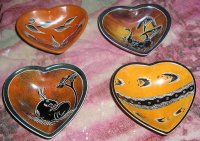|
Soapstone rocks are sourced in Kenya's Nyanza province in a place known as Tabaka. Soapstone products have become synonymnous with Kisii people because it is the only place in Kenya where these soapstone rock mines covering over 25 kilometers squared are found. The soapstone comes in a variety of colours: dark reddish, pinkish, gold brown, grey creamish and even black.
How seriously the local people place on soapstone as their income generating activity can be seen by the manner in which the carvers have perfected their skills. The greatest consumers of the product are tourists who often buy and take the decorative soapstone items as gifts for friends or for home decoration.
The trade of soapstone comprises both the men and the women, young and old. Traditionally, it is men who do the digging of the stone from the mines or the quarry as well as carving the products in the required designs. The women's part involves polishing and washing the finished products as well as applying the shining wax cream popularly known as cobra wax. Though soapstone is a leading export product, it is a very fragile commodity, which requires extra care, particularly when it comes to handling and exporting or transfering the finished product from the rural areas to Nairobi and even to the port of destination be it in Kenya's Mombasa port or overseas. |

 The
mining of these rocks is carried out using crude tools, which is labour
intensive. Due to the market potential and the easy availability of
this natural resource commodity, many Kisii people have come to rely
on it as one of their major sources of income. The raw quarry stones
are excavated by hand and carried to workshops that are up to 10 kilometers
away. The stones are first worked with a panga (machete), to break the
stones into a manageable size and get the rough shape. A kisu (smaller
knife) is then used for more detailed work. Finally increasingly fine-grained
sands are used to polish and finish the piece.
The
mining of these rocks is carried out using crude tools, which is labour
intensive. Due to the market potential and the easy availability of
this natural resource commodity, many Kisii people have come to rely
on it as one of their major sources of income. The raw quarry stones
are excavated by hand and carried to workshops that are up to 10 kilometers
away. The stones are first worked with a panga (machete), to break the
stones into a manageable size and get the rough shape. A kisu (smaller
knife) is then used for more detailed work. Finally increasingly fine-grained
sands are used to polish and finish the piece.  Since the soapstone
is sourced from the local community farms, the mining and carving of
the soapstone is often treated as a family income generating activity
and as such it is carried out at a family level. It is at the family
that marketing of the finished products to interested buyers is carried
out and at times through group work or through the co-operative.
Since the soapstone
is sourced from the local community farms, the mining and carving of
the soapstone is often treated as a family income generating activity
and as such it is carried out at a family level. It is at the family
that marketing of the finished products to interested buyers is carried
out and at times through group work or through the co-operative.